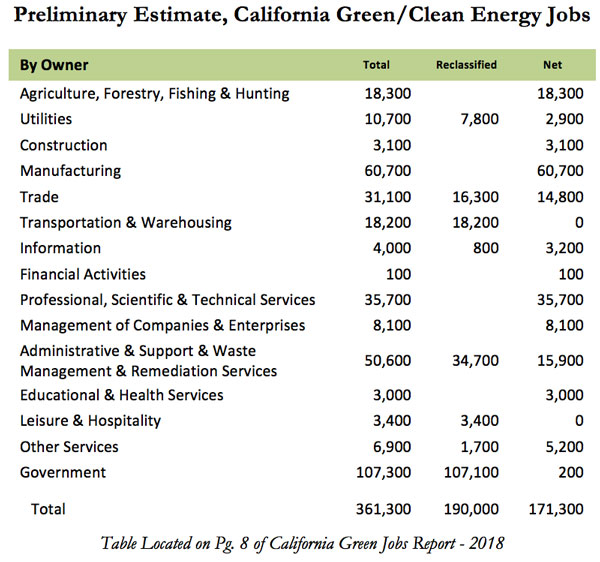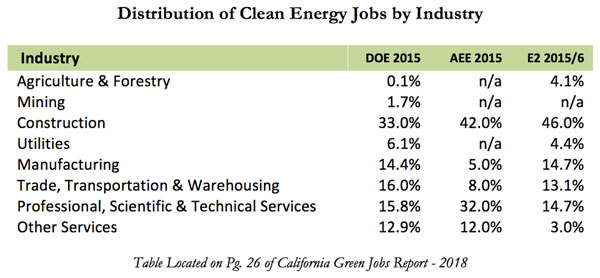[Source: California Center for Jobs and the Economy] As part of its ongoing research and analysis of trends and policies affecting the California economy, the California Center for Jobs and the Economy issued a new report today assessing the extent to which the state has transitioned to a Green Economy and concluding that green job “growth” to date is largely due to reclassification of existing jobs and the miscounting of temporary construction and other indirect jobs.
California now has more than 17 million nonfarm jobs. Of that, the report’s preliminary estimates are that only 171,300 are new direct green jobs, just one percent of total jobs. If existing jobs reclassified as “green” in other studies are taken into account, that number jumps to 361,300 jobs. At best, combined new and reclassified green jobs still represent 2.2 percent of the state economy. It is important to note that most green jobs being “created” are in large part existing jobs that have been reclassified as “green” based on a variety of inconsistent definitions and do not represent true job creation or economic growth. Not only does this re-classification give a false impression of actual green job growth, it raises concerns about the ability of the state’s current policy reliance on development of a Green Economy to create jobs necessary to sustain California’s future economy.
Moreover, many of the jobs counted as “green” in prior studies are lower-wage and short-term construction jobs, not well-paying sustainable middle-class jobs on which a future Green Economy would need to be built. As state policymakers continue their attempts to transform the California economy most notably through energy policy, a transition reliant on these short-term and lower-wage jobs will have a significant long-term impact, especially as these policies affect higher-wage manufacturing and other traditional middle-class jobs. Future reports from the Center will further investigate these wage issues.
While state policies may serve to launch a green industry, employers will still need to operate at profit levels allowing their continuance and growth, and they face many of the same competitive challenges as employers providing the other 98 percent of the state’s jobs already face. The report contains examples of the failures that occur when policy promises for green jobs do not deal with these constraints as well. By failing to address these competitive factors, the broader range of the job benefits from state policies has followed two courses: green jobs for those activities that have no choice but to be in California and greener pasture jobs where operating costs have driven these jobs to other states and nations.
The new report, “California Green Jobs: An Updated Review,” also, for the first time, seeks to define what a “green job” is and the economic significance these jobs play in the current and future economy. This report represents the first phase in a major research project by the Center for Jobs and the Economy and builds off of previous Center reports on the issue from 2016 and 2015.
KEY FINDINGS
Reclassification of existing jobs and inconsistent definition of “green jobs” overstates reality of Green Economy. Efforts to quantify green jobs began to support various recent policy initiatives. The state passed its landmark greenhouse gas reduction legislation in 2006; the California Employment Development Department began their efforts to quantify green jobs in 2008. Various federal, state and non-profit organizations have attempted to quantify green jobs, but with no consistent definition or metrics. Some estimates include reclassification of existing jobs, which leads to overestimating net job gain as a result of new state policy. Additionally, several green job estimates include clean energy jobs from nuclear and natural gas, industries inconsistent with the state’s current approach in its aggressive move toward an all-electric economy.
Most “green job” definitions rely heavily on reclassification of existing jobs. Beyond a lack of consistency, most studies seeking to define the Green Economy have simply reclassified existing jobs with a “green” nexus, which has significantly inflated the number of green jobs. Long-standing jobs such as park workers, environmental regulators, garbage workers, public transit and water and sewer treatment are included in the totals. For example, of the total 107,300 green Government jobs estimated in the Center’s report for 2016, only 200 are new jobs. The remaining 107,100 jobs are the result of reclassification. This reclassification gives a false narrative about green job growth, providing state policymakers with an inaccurate estimate of true green job growth and the strength and viability of the Green Economy. Accuracy is particularly relevant on decision-making for policies moving forward.

Current “green jobs” are just two percent of total nonfarm jobs in California. Based on preliminary estimates by the Center, there were 171,300 green/clean energy jobs in California in 2016. If existing government and other jobs reclassified as green/clean energy jobs are included, the total jumps to 361,300. Combined net and reclassified jobs represents 2.2 percent of the 17 million total jobs in 2016. The total number of new direct jobs that can be directly connected to current state policies represent only 1.0 percent of total jobs in 2016.
Move away from certain clean energy programs will further reduce green job estimates. Most current green job calculations include natural gas and other “clean energy” jobs that are no longer included in the regulations promoting a renewable Green Economy. For example, some current green job quantifications include a “clean energy” definition that includes nuclear, natural gas and hydroelectric. State policy is rapidly moving away from these “clean energy” sources, which we project will result in a rapid reduction of the green jobs associated with these industries.
In the Legislature, efforts to mandate all homes stop using natural gas and use only electricity would result in the loss of green jobs associated with the advanced natural gas industry while increasing the cost of housing by at least $7,200 per home. On the regulatory front, earlier this year, the California Public Utilities Commission attempted to impose a moratorium on new commercial and industrial natural gas connections in the Los Angeles region. Again, these policies will directly reduce the number of green jobs currently counted from the natural gas/clean energy industry.
The current Green Economy is over-reliant on temporary construction jobs and is unsustainable for future middle-class growth. Most prior attempts to quantify green jobs in California include large segments from temporary jobs that may last a matter of weeks or several months, especially lower-wage service and short-term construction jobs. In reports that track this data, temporary jobs make up more than half of the total jobs. Some prior reports count a job as “green” if a worker spends as little as 25 percent of their time on the defined activities (California Employment Development Department, California’s Green Economy, Summary of Survey Results, October, 2010).

As demonstrated in the table above, construction alone constitutes one-third to nearly one-half of the clean energy estimates, reflecting the fact that most of the indicated jobs in this period came from construction of generating plants and associated infrastructure to comply with the state’s Renewable Portfolio Standard, along with installation services related to solar panels, charging stations, building efficiency measures, and similar components. These are primarily temporary jobs resulting from the expenditure for (often heavily subsidized) green investment, rather than the development of permanent jobs capable of providing longer-term economic benefits from state policies. Additional analysis of wages will be presented in a future report.
Alliance members: click to read the full report on the Members Only page of our official website: scroll down to the STUDIES, SURVEYS, RESEARCH category.
Source: California Center for Jobs and the Economy


